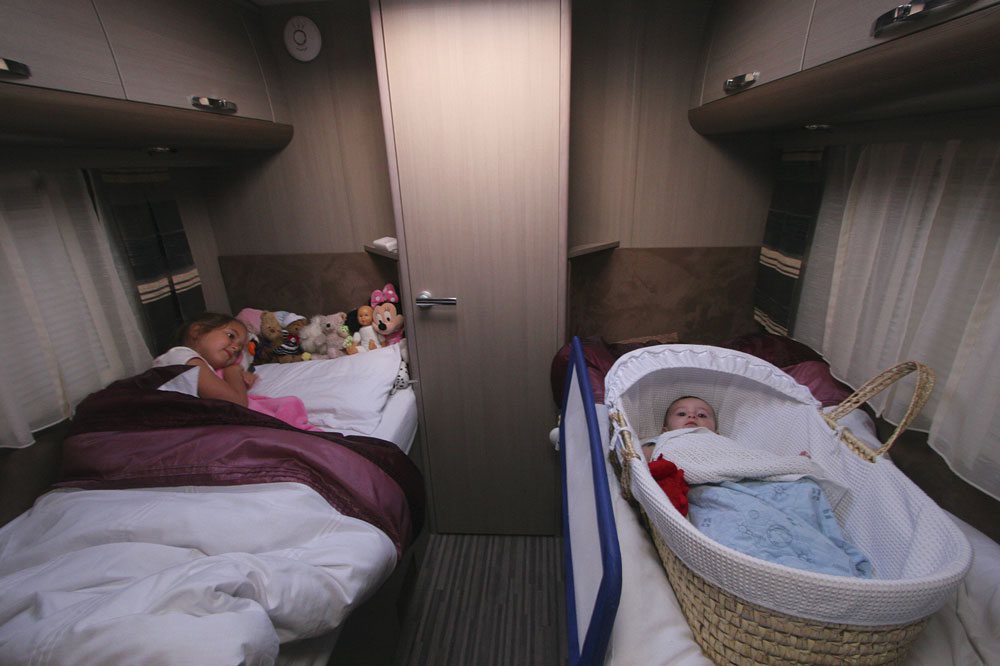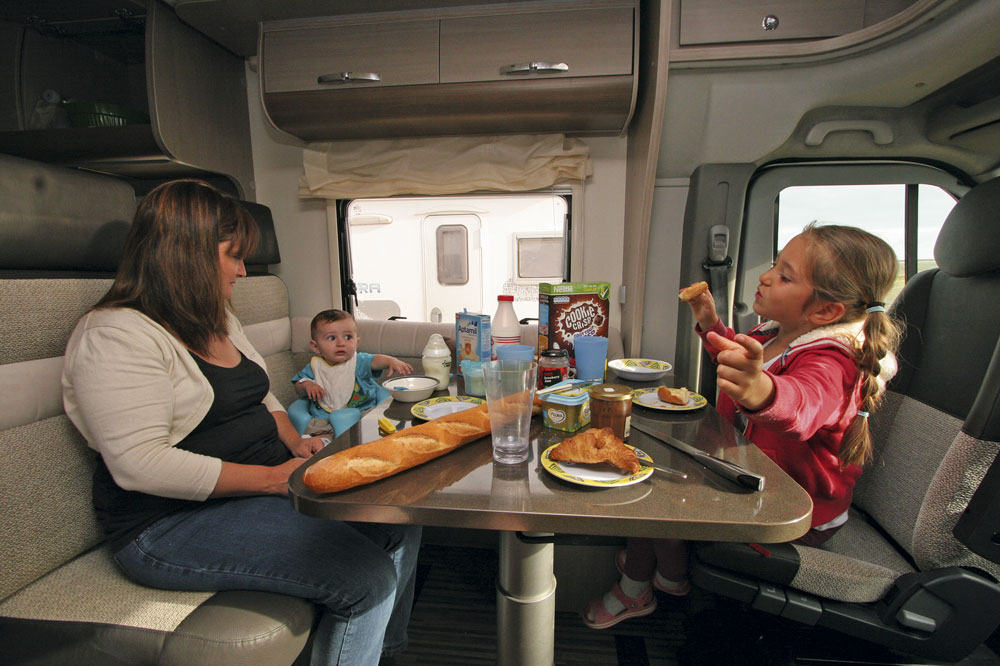Why campervans are so child friendly
Much of the motorhome market is about two people on tour, and plenty of models have just two berths and/or only two travel seats.
If you want to accommodate more folk, generally the amount of choice reduces the more people you want to carry, though up to seven berths are possible (Rimor even has a model with four bunk beds).
Harder to find than more berths are sufficient belted travel seats, with remarkably few motorhomes or campervans offering more than a quartet of seatbelts.
There are numerous models that claim sleeping capacity for more people than can safely travel onboard. Don’t give up, though – there are options for most families.
Once you’ve found a model with enough belts you can’t, unfortunately, tick that box and move on, especially if some of your passengers are young enough to still need baby or child seats.
Where dining tables do not fully remove (the best solution for safe travel) they may leave insufficient space or legroom to fit a child seat.
Then, some child seats require a length of seatbelt that is often not found in a campervan or motorhome; motorhome belts are rarely well endowed.
Isofix is rare in motorhomes and campervans, although it is slowly – very slowly – spreading to more models and more brands.
Adria and Westfalia are among the manufacturers offering Isofix, as do the OEM campervans – Ford Nugget, Mercedes Marco Polo and VW California.
Without Isofix you need to be aware that child seats sometimes don’t work well in motorhomes – in one campervan we tested recently a child seat was able to slide off the side of a forward-facing bench when the vehicle went around a roundabout! Child seats, therefore, often work best when placed next to a wall.
Getting extra beds in a campervan

Having enough sleeping space is often more easily solved than finding a campervan with sufficient seatbelts, especially if your kids (or friends) are happy to sleep in an awning, or a tent alongside the vehicle. Older children may actually prefer having their own separate space, while modern inflatable awnings from firms such as Outwell are so easy to erect that you can allay any bad memories of tent poles and unfathomable instructions.
Most smaller campervans, such as VW T6s and Ford Transit Customs, will have a bed in the pop-top, or at least the option of adding one. These usually have adult-sized mattresses and are sometimes even better than the bed below.
Most campers of this type also have four seatbelts, but there are some models with five travel seats (or even more with extra slot-in removable seats). If you’re considering a model with a double passenger seat in the cab, however, be aware that these are a rather heavily compromised arrangement.
Move up to larger high-roof van conversions and four-berth options are fairly few and far between. There are several manufacturers (including Auto-Sleepers, Dreamer and Swift) that offer twin lounge layouts and even bunk beds (try Dreamer and WildAx) can be found in van conversions, while others (Auto-Trail, Globecar, Hymer, etc) go down the route of adding a pop-top above the original high-top.
The elevating roof is then just to provide an extra bedroom (full standing room already exists), but as with VWs you might not want to sleep in a canvas-sided space in mid-winter.
Moving up to larger coachbuilt motorhomes will give you more living space and, while overcab coachbuilts might seem a bit ‘old hat’, that luton bedroom will make a great kids’ den – or even an adult space in some models. Unlike the more fashionable drop-down beds in low-profile motorhomes, the overcab bed won’t interfere with the living area when occupied.
If you can stretch your funds (or buy a secondhand motorhome), an A-class might be an even better option. Almost all A-classes have a drop-down bed in the cab (almost instantly available for mum and dad), while a twin single beds arrangement aft can work well for offspring. A Hymer ML-I like this provided the Editor with an especially successful trip to Denmark, travelling four-up.
The most obvious layout, though, for family motorhoming, is a bunk bed design. It’s best if the bunks are as separated as possible from the lounge (and well away from the habitation door, too) and you’ll find bunk bed coachbuilts from a number of makers, at different price points (though typically in entry-level ranges), and in lengths from 6m up to 7.5m.
These floorplans are often popular with hire fleets, too, so there’s the opportunity to try before you buy – always a good idea if you’re investing in your very first leisure vehicle.

Check payload and storage on a motorhome or campervan
In the six-berth coachbuilt sector another option is to go for a model with two lounge areas (such as in this Bailey model ). The extra living – and lounging – space is very tempting if you’re travelling mob-handed but these layouts cannot usually match the storage space of a bunk bed or garage layout.
Having found a shortlist of models with enough belts and berths, it’s essential not to get carried away and sign the order form straight away in your excitement. Next, you need to check out storage and payload. It’s obvious that the more people that travel in the campervan the more stuff they’ll want to bring with them.
That could include pushchairs for little ones or bikes for teenagers. Even six spare pairs of shoes and six coats can take up a lot of room, let alone a sextet of outdoor chairs, so, if you’re tempted by non-fixed-bed layouts, do think carefully where you’re going to put everything. A garage might become a must-have.

Then you need to think about what it all weighs. Payloads are usually calculated with just a (75kg) driver onboard, so get everyone to stand on the scales and tot up the total. Then think about all their gear.
If the payload quoted looks marginal for two or four people then it’ll leave you very overloaded with six. This might be the time to look at chassis upgrade options, even on VW campers (which vary from 2,600kg to 3,200kg gross weight) while coachbuilts will usually need to be on heavy chassis (more than 3,500kg, with driving licence implications) to have enough capacity to cope with a larger family and all their gear.
That just leaves you to pick the most practical upholstery option available and leave the removable carpets in the garage at home. Then you’ll be ready for the very best family holidays, ones your kids will always fondly remember.











Recent Updates
Engine management lights: all you need to know
What is the engine management light? What does it mean, and what do I have to do? ...
Motorhome air suspension: all you need to know
Motorhomes are heavy and the additional weight of equipment and height of the bodywork can increase the loads ...
Motorhome WiFi: how to get better motorhome internet
Staying connected on the move is more and more essential, so relying on campsite WiFi isn't an option – here ...
A class of their own - our guide to A-class motorhomes
Thinking of trading up to an A-class, or even going straight to the top of the motorhome tree? We guide you ...
Explore overseas on a motorhome dream tour
Enjoy exotic travel in a campervan or motorhome by hiring, swapping with someone else or exporting your ...
Motorhome water systems: everything you need to know
On-board water is an important part of every motorhome – here’s everything you need to know ...
Campervanning in Europe: what you need to know
Whether you're planning a leisurely drive through the French countryside, navigating bustling city streets in ...
Campervan security: all you need to know
With thefts on the increase, it’s important to know how to keep your campervan secure and prevent campervan ...
Campervan furniture: everything you need to know
Our campervan experts guide you through all the essentials for your campervan, including tables, chairs, ...
Campervan finance: how to fund your purchase
Here we look at the different types of campervan finance available, to help you decide what’s the best option ...
Other Articles
Britain’s best used motorhomes
Want a great motorhome without paying the premium for a new one? Here's a guide to the best you can get in the pre-owned market for each layout, ...
Which motorhome? Choosing the perfect motorhome for you
Choosing a motorhome or campervan is one of the biggest buying decisions you’ll ever make, so it's important ...
Campervan washroom essentials: stay fresh on the road
Our guide will take you through the campervan washroom essentials you'll need so you're well-prepared for ...
Dogs in campervans: all you need to know
Follow our advice and your dog will enjoy campervanning as much as you do ...
Electric campervans: all you need to know
Our guide will take you through everything you need to know about electric campervans and what the future ...
Motorhome electrics: a complete guide to your motorhome electrical set-up
Motorhome electrics can dramatically enhance the convenience and comfort of your vehicle – but they can be ...
Lighting for campervans: all you need to know
We guide you through all the lighting options available for you and your campervan, including interior ...
Electric bikes for motorhomes: our ultimate guide
Read our comprehensive guide to electric bikes for motorhome owners, helping you add electric power to your ...
Our guide to 'cheap' motorhomes in 2024
If you're on the hunt for an affordable new motorhome, this is the best place to start – we've rounded up a ...
Campervans in winter: all you need to know
Here's your guide to preparing your campervan for the colder months, whether you will be using it or putting ...